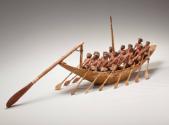Model Fast Boat with Fourteen Rowers
Model Fast Boat with Fourteen Rowers
Place of OriginEgypt, probably from Meir (Cusae)
Date11th–12th Dynasties (2130–1802 BCE)
Dimensions14 1/4 × 14 1/2 × 42 3/4 in. (36.2 × 36.8 × 108.6 cm)
MediumWood, gesso, polychrome paint, linen.
ClassificationSculpture
Credit LinePurchased with funds from the Libbey Endowment, Gift of Edward Drummond Libbey
Object number
1972.15
On View
Toledo Museum of Art (2445 Monroe Street), Gallery, 02, Classic
DescriptionA carved wooden model of a river boat featuring a long, slender hull with a pointed bow and stern, painted in a creamy buff tone. The hull is hollowed out and features a raised central shelf (spine) running longitudinally down the center of the deck; this shelf is notched to receive seven wooden thwarts (benches) which rest on both the shelf and the gunwales. The gunwales are raised and decorated with a red stripe, and the deck beams are painted red. A single mast is positioned amidships, painted creamy buff with black stripes at the tip. The stern features a reinforced block with an indentation for a steering oar, though the steering gear and helmsman are missing. Fourteen wooden figures sit in pairs on the thwarts; they act as rowers, holding mismatched oars. The figures exhibit inconsistent iconography: some wear short black wigs and white kilts, while others wear white headbands associated with funerary contexts. Some figures have linen wrapped around their kilts.
Label TextThis slender wooden boat was built for speed. Unlike heavy cargo barges, this "fast boat" represents the vessels used by Egyptian officials to rush messages up and down the Nile. In a tomb, it provided the deceased with a magical vehicle to traverse the "Winding Waterway" of the stars in the afterlife. Look closely at the crew—they are a "harlequin" team. The fourteen rowers do not match each other; some wear simple black wigs, while others wear the white headbands of priests or funerary workers. Research reveals that an art dealer in the early 20th century likely assembled these mismatched figures from at least seven different ancient models to create a "complete" boat for sale. Despite the mixed crew, the hull itself is an authentic and rare example of shipwright traditions, possibly from the site of Meir.Published References"Recent accessions...;" Art Quarterly, vol. 35, no. 4, 1972, p. 435, repr. 434.
"La Chronique des Arts," Gazette des Beaux-Arts, vol. 81, no. 1249, Feb. 1973, repr. p. 101.
"Treaures for Toledo," Toledo Museum of Art Museum News, vol. 19, nos. 2, 3, 1973, p. 44, repr.
The Toledo Museum of Art: A Guide to the Collections, Toledo, 1976, repr. p. 6.
Peck, William H., Sandra E. Knudsen and Paula Reich, Egypt in Toledo: The Ancient Egyptian Collection at the Toledo Museum of Art, Toledo, Toledo Museum of Art, 2011, p. 46, repr. (col.) p. 11, 47, (det.), p. 46.
Merriman, Ann M., Egyptian Watercraft Models from the Predynastic to Third Intermediate Periods, Oxford, Archaeopress, 2011, p. 330, no. 427.
Exhibition HistoryToledo Museum of Art, Hands On Egypt, Sept. 18, 1998 - Aug. 31, 2000.
Toledo Museum of Art, The Egypt Experience: Secrets of the Tomb, October 29, 2010-January 8, 2012.
Comparative ReferencesSee also Landstrom, Bjorn, Ships of the Pharaohs, New York, 1970, pp. 71, 75.cf. Hayes, William C., The Sceptre of Egypt, New York, 1953, vol. I, pp. 267-274.
cf. Glanville, S.R.K., Catalogue of Egyptian antiquities in the British Museum II: Wooden boats, London, 1973, pp. 20-22, pl. IVa.
cf. Spanel, Donald B., "Ancient Egyptian boat models of the Herakleopolitan period and eleventh dynasty," Studien zur Altagyptischen Kultur, bd. 12, 1986, pp. 243-253.
Before 1880
5th Dynasty (2498–2345 BCE)
9th Dynasty (2130–2040 BCE)
about 1500 BCE
1st-2nd century CE
1st century CE
1st-2nd century CE (?)
1st-2nd century CE (?)

Membership
Become a TMA member today
Support TMA
Help support the TMA mission














